- Rule, Britannia, no more?
- Unpopular Opinions: US Quadball Cup 2023
- Proven Contenders: University of Virginia
- Proven Contenders: Rutgers University
- Proven Contenders: University of Michigan
- Proven Contenders: Creighton University
- Different Perspectives: A Look Inside USA Ultimate
- Antwerp QC, Much of Belgian Core, Leaves Competitive Quidditch
Part IV
Rock Hill Roll Call is your in-depth guide to the 80 teams that will compete for the title of World Cup 8 Champion. We’ve reached out to writers and analysts all over the country to bring you the lineups, strategies, focal points and aspirations of each and every attending team. Whether you are looking for a leg up on the competition or just want a detailed preview of the sport’s main event, this is the place for you.
 By Mike Pascutoi
By Mike Pascutoi
It’s difficult for any observer to write about the success of the RPI Remembralls without talking about the effect that beater Mario Nasta has on opposing teams. To many, Nasta is their standout, the focal point of the team’s success and the most talented player on their team.
However, they are wrong. Anyone who has seen RPI play this past fall season can tell you that, at best, RPI’s beater play has been above average, regardless of the talent of Nasta. At worst, it has been a liability that almost risked their chance of qualifying for World Cup during bracket play of the recent Northeast Regional Championship.
The real success of RPI lies in the use of their two highly versatile keepers: Sam Nielson and Vibhav Kalaparthy. Despite their lack of name recognition and experience, this keeper line has been the main component in RPI’s rise from finishing dead-last at the Northeast Regional Championship two years ago to becoming a second-tier Northeast contender.
Let’s begin with Nielson. As a freshman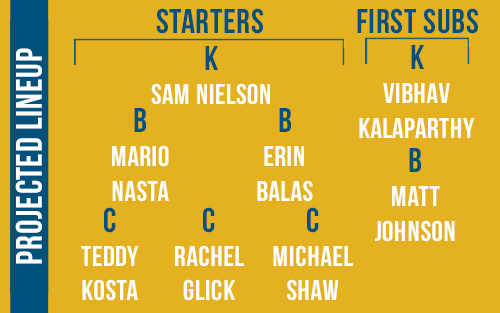 last year, Nielson stepped up to be one of RPI’s top scorers, despite playing a heavy distributing role in their offense. Nielson’s passing accuracy is among the best in the Northeast, and his ability to float passes halfway across the field has allowed RPI to open up their offense and take advantage of athletic mismatches on the field. Furthermore, despite a lanky frame, Nielson is incredibly hard to tackle and is able to command the attention of an opposing defense long enough to slip one of his perfect passes into a sliver of a space.
last year, Nielson stepped up to be one of RPI’s top scorers, despite playing a heavy distributing role in their offense. Nielson’s passing accuracy is among the best in the Northeast, and his ability to float passes halfway across the field has allowed RPI to open up their offense and take advantage of athletic mismatches on the field. Furthermore, despite a lanky frame, Nielson is incredibly hard to tackle and is able to command the attention of an opposing defense long enough to slip one of his perfect passes into a sliver of a space.
Contrasting this is Kalaparthy. Despite being a first-year player, he has an amazing way of making plays and the ability to collapse a defense with his patient, deliberate play. Unlike Nielson, Kalaparthy prefers to use his power on drives or play a more secondary ball-handling role, either scoring on close-range shots or using the extra defensive attention to find an open teammate for a quick pass.
World Cup VIII will feature a demonstration of the ability of keepers to single-handedly take over games, from Alex Browne and Tony Rodriguez in the West to David Stack and Jayke Archibald in the Northeast. With this colossal display of talent, look for Nielson and Kalaparthy to remain under the radar even as they continue to lead RPI on their ascension into prominence.
By Devin Sandon
The X-Factor for RPI will be their beating.
Nasta carved out a reputation for himself over the summer at Northeast Fantasy, predominantly for his mechanics. However, after a fall season with little real competition (one game against an opponent in the top eight of the region, three games against World Cup-qualified opponents), RPI displayed a number of bad habits, particularly in their beating. The first thing that stood out about RPI’s beating this semester was their willingness to make long throws. Against teams with weaker passing games and weak beaters, this allowed Nasta to take over a pitch and pin opponents into their own keeper zone. However, more experienced teams were able to bait long throws and pass the ball off to take Nasta out of plays. The second thing that stood out is that the defense is overly reliant on Nasta’s beats. The second beater, at least some of the time, seemed to be merely holding onto a ball for Nasta to use after making a long throw with his own.
For RPI to have a strong showing at World Cup, they need their second beater to be an actual factor in games, and they need Nasta to be more mobile and have better positioning, rather than using his long throws as a crutch.
 By James Hicks
By James Hicks
George Mason University is not what you would call a team full of elite-level talent or athleticism, but what stands out about them is their overall effective offensive game and quaffle movement. When a team is able to hold offensive possession for 14+ minutes in a game, they’ll be difficult to beat. Their slow and controlled offense, usually run by second-year keepers Ben Mertens and Ryan Martin sometimes borders on the line of legality, but always plays a mental game with opponents. It often forces them into sloppy and rushed offensive possessions in effort to build momentum against the slow-moving opposition. Short and controlled passing stretches the time of their offensive possessions until they can try and find a high-percentage shot. To compliment this, GMU also has a blooming point defender in Jonathan Milan, who makes key tackles and causes turnovers to keep the offense effective and their time of offensive possession high.
This also plays to the strength of their beaters, who are able to rest at mid-field, waiting for an opportunity to stop a fast break and hand the ball back over to their offense. Their patience and short, compact passes is a quality they’ll need to bring to South Carolina in order to have positive showing.
By James Hicks
While their controlled offense and solid point-man-zone defenses have produced a successful season on paper, GMU snuck into World Cup in their first official USQ season with Mid-Atlantic Regional pool play wins over Duke University, Carnegie Mellon University and a notable 60*-40 win over University of Virginia in the Sweet 16. The biggest factor that will make the difference between a strong showing in South Carolina and being on the wrong side of the 80-team standings will be their ability to break away from the same offense that got them to this point. Coming off a year where GMU built a handful of impressive showings due to a slow-paced strategy centered around slowing the pace of the game, they will need to give their new quaffle talent room to use their athleticism.
The GMU offense will live and die 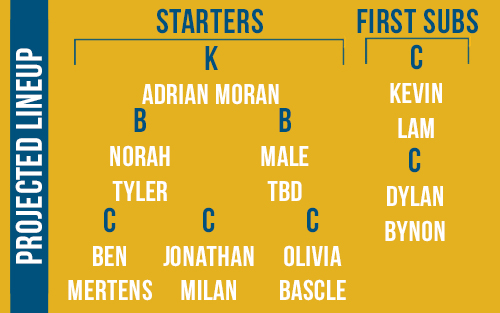 through new keeper, Adrian Moran. GMU has not seen a ball carrier that has the ability to run a fast-paced offense and score with ease, so they will have to revamp their entire scheme in order to look like a World Cup-caliber offense instead of a squad throwing out a survival tactic. This can also open up the game for chasers Milan and Olivia Bascle, whose talent and potential seems to have remained stagnant in GMU’s survival-type offense. In order to take the next step, GMU needs to use their newly-recruited athleticism in the chaser line to put up points and capitalize on fast-break opportunities. This is even more important since the squad’s beaters haven’t improved this semester in the ways GMU truly needs.
through new keeper, Adrian Moran. GMU has not seen a ball carrier that has the ability to run a fast-paced offense and score with ease, so they will have to revamp their entire scheme in order to look like a World Cup-caliber offense instead of a squad throwing out a survival tactic. This can also open up the game for chasers Milan and Olivia Bascle, whose talent and potential seems to have remained stagnant in GMU’s survival-type offense. In order to take the next step, GMU needs to use their newly-recruited athleticism in the chaser line to put up points and capitalize on fast-break opportunities. This is even more important since the squad’s beaters haven’t improved this semester in the ways GMU truly needs.
This team has shown they can slow the pace of the game down with their defense enough to keep quaffle points against low, but if they want to make an impact at World Cup 8, they need to speed some things up.
 By Eric Wasser
By Eric Wasser
Anyone at all familiar with University of Minnesota’s program knows they have been very successful at running the hoop-zone defense for years. They utilize high beater pressure to force mid-range shots, which are easily handled by the individualscovering each hoop. This has distinct advantages against teams with a less-developed passing game or reserved beaters. But, a competent, aggressive lead beater can create a driving
lane. This creates a one-on-one at a hoop for the chaser,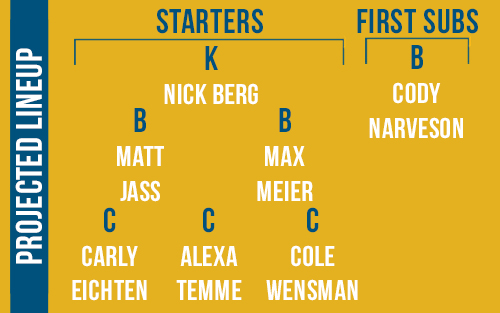 as well as an opportunity to utilize the other chasers left unmarked due to hoop coverage. The zone’s most important aspect is that it is something most teams face infrequently, so Minnesota is able to take advantage of the opponent’s transitional period. If a team comes into the game with an established plan to face the zone and is able to consistently break through the beaters, Minnesota’s zone becomes nothing more than a physical battle around the hoops.
as well as an opportunity to utilize the other chasers left unmarked due to hoop coverage. The zone’s most important aspect is that it is something most teams face infrequently, so Minnesota is able to take advantage of the opponent’s transitional period. If a team comes into the game with an established plan to face the zone and is able to consistently break through the beaters, Minnesota’s zone becomes nothing more than a physical battle around the hoops.
 By Eric Wasser
By Eric Wasser
Cody Narveson has been a perennial staple in maintaining solid keeping for Minnesota’s zone for years. This year, however, he surprised many people by returning to the Midwest Regional Championship as a beater.
Claiming to have made the position switch because it would be easier to produce a competitive keeper from the team’s rookie class, Narveson added experience and physical strength to Minnesota’s defense late game, running himself as a second sub. The team has now had more time to develop young players, which could allow Narveson to return to keeping. However, I would not be surprised to see him develop himself further with a bludger in hand. This versatility strengthens Minnesota’s defense in all aspects. As displayed in Grand Valley, this team now has very few weak spots and is eyeing a solid run at World Cup 8, if only their hoop zone holds steady.
Graphics and photo illustration by Amanda Dallas. Original photos by Nicole Harrig and Matt Dwyer.





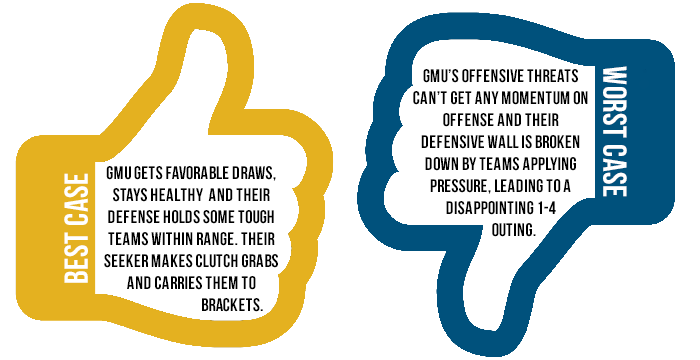


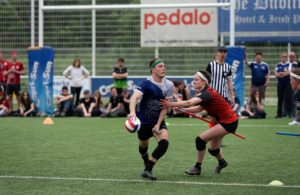

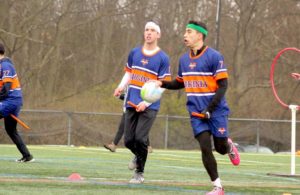
One Comment